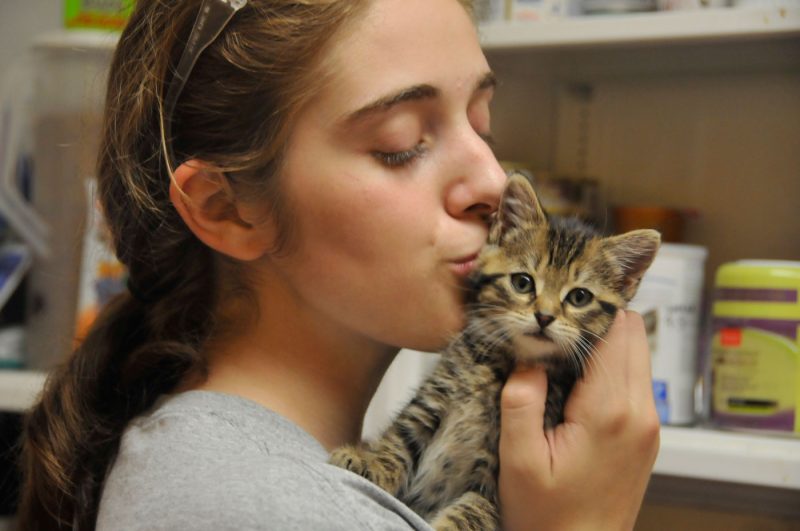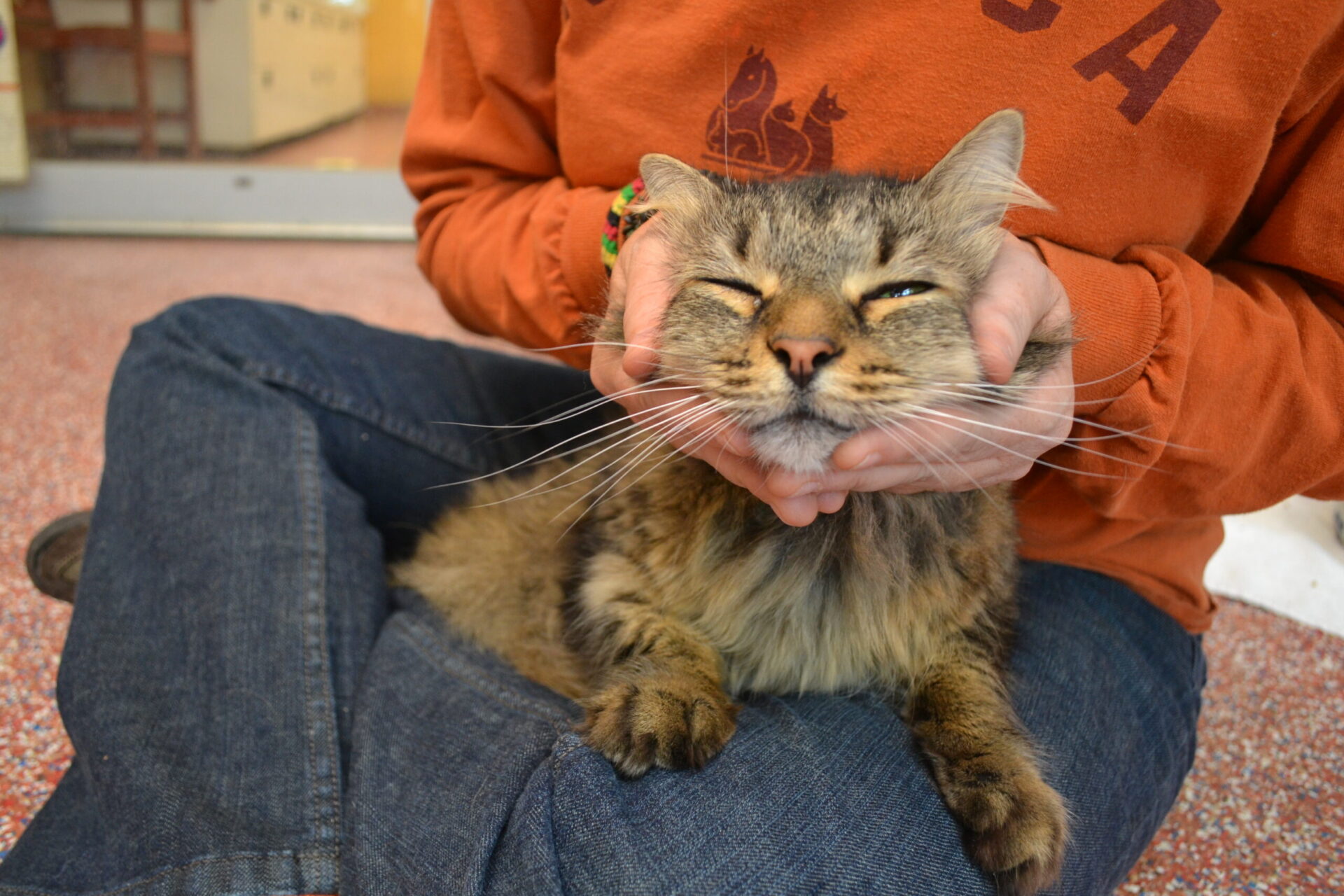
General Considerations:
- Cats generally live between 12 and 18 years. However, cats are living longer all the time and it is not unusual for a cat to live until 20 years old or older. Take a moment to consider that you are prepared for this long-term commitment of your time, energy and finances.
NOTE: For outdoor cats, the life expectancy dramatically decreases to just 3 to 5 years. Outdoor cats are at far greater risk of illness and serious injury which shortens their overall life expectancy significantly. - If you have other pets at home, especially other cats or dogs, speak with an Adoption Counselor before adopting. They can give you helpful advice for how to choose your new kitten and how to slowly introduce it to your home environment and your current pet household to give the very best chance of a positive adoption outcome.
- In most cases, kittens stay with their mother until they are weaned at 8 weeks of age. At weaning, they are slowly switched to regular food and water. Most young kittens in shelters are available for adoption around 8 to 16 weeks.
- Most shelters should spay/neuter kittens and cats before adoption. If they do not, contact your family veterinarian before adoption to discuss setting up spay/neuter surgery.
- Be sure to give your new cat or kitten plenty of time to acclimate to their new home. It is not unusual for it to take several days for cats to adjust and even young kittens can take a little time to feel comfortable, especially if they have been transported from one shelter to another and then adopted into your home. A shelter, vehicles, veterinary treatments and lots of changes can be a challenge, so practice patience and give your new friend some time to adjust.
- The information included here contains basic considerations but is not an exhaustive list of all the things to think about before adopting a kitten. We recommend establishing a relationship with a family veterinarian if you do not already have one and ask questions about things you should know before adoption. It is always a good idea to speak with family and friends who have had kittens as well as the Adoption Counselors from the shelter you are adopting from. They can provide valuable information.
Housing:
- Most cats can live happily indoors for their whole lives and never need to go outside. With the proper enrichment, cats are happy, healthy and fulfilled with an indoor lifestyle.
- Consider the risks before letting your cat outside. Cats are at significant risk for exposure to disease, dangerous encounters with wildlife, vehicles and other hazards that could cause them harm and shorten their life expectancy.
- Kittens should never be let outside before they are at least 6 months old and are spayed/neutered. Kittens younger than 6 months are too young and vulnerable and may not have had their complete set of vaccines, so are at increased risk if let outdoors.
- If you choose to let your adult cat outside, always ensure they are spayed/neutered and microchipped. Always ensure that the contact information (owner name, address, phone numbers) are kept up to date with the microchip company.
- Bring your cat indoors if there are any weather advisories, such as extreme heat or cold or storms.
- Cats are generally happy to share your home with you, but it is a good idea to have some special items just for them. Beds, hidey houses, cat trees and other items can provide a habitat for your cat so that they can engage in their normal behaviors.
Food & Water:
- Kittens will be on kitten food (wet/dry) until approximately 10 – 12 months of age.
- Be sure to read the feeding guide instructions on the kitten food packages to ensure the proper amount is fed daily.
- Consult your family veterinarian for guidance on proper weight gain and when to slowly transition a kitten to adult cat food.
- Kittens and cats should be offered plenty of fresh clean water every day.
- Outdoor cats should always have access to fresh water. In the colder months, ensure the water is changed and doesn’t freeze.
- There is people food that should never be given to cats. Click HERE for more information.
Litter:
- Generally, kittens do not have to be litter box “trained”. Most kittens learn this behavior from their mothers. Kittens who are bottle raised by humans may need some guidance, but generally they have an instinct to use the litter box. Consult your veterinarian, a guidebook or reputable website (such as kittenlady.org) for more information.
- A household should have one more litter box than the number of cats living there. For example, if you have two cats, there should be three litter boxes in the home.
- A variety of litter is available. For young kittens, avoid clumping/clay litter as it can pose a risk if ingested and it can be dusty for their respiratory systems. Pelleted litter is a good choice.
- If your kitten is not using the litter box properly, speak with your family veterinarian and consider taking the kitten in for an exam to rule out any underlying health conditions. In many cases, inappropriate litter box use is related to a health problem. Sometimes, inappropriate litter box use could be a result of stress. For more information, go to: Litterbox issues
Veterinary Care:
- It is a good idea to establish a relationship with a veterinarian before adopting. Ask them questions in advance about the vaccine and preventative treatment schedule and probable costs associated with necessary exams and treatments.
- The New Hampshire SPCA strongly recommends that owners bring their new cat or kitten for a vet visit and exam approximately two weeks after adoption.
- If you are adopting a kitten or cat that will not be spayed or neutered before adoption, you will need to plan to do so. Spaying and neutering can be somewhat expensive surgery. Although done frequently, you are relying on the expertise and experience of trained veterinary medical staff to administer anesthesia, perform surgery and safely recover your pet. Owning an unaltered pet can be a big risk for the cat as it poses long term health consequences. In addition, unwanted litters can be challenging and costly. For more information, go to our Spay and Neuter webpage.
- Most kittens will need to be seen for required core vaccines and preventative treatments after adoption. Many cats may require additional treatments after adoption as well.
- Some shelters will have already provided some of these treatments and will tell you which ones are outstanding that you will need to get at your veterinarian.
- Be sure to read through the adoption paperwork thoroughly and discuss all outstanding vaccines and treatments with the Adoption Counselor.
- In the state of New Hampshire, it is required by law that all cats be kept up to date on a rabies vaccine. This is regardless of the cat being indoor or outdoor.
- Plan on cats needing an annual veterinary visit and exam and probable boosters of vaccines every year or every three years, depending on the core vaccine schedule requirements.
- Some cats will need to be seen by the veterinarian more frequently, depending on any underlying health considerations they may have.
- Veterinary treatments can be costly. It is a good idea to be sure you are prepared for the possible financial commitment that owning a cat will have for years to come.
Enrichment:
- Kittens love to play! Be prepared for lots of rambunctious behavior both day and night. They also love to sleep and will likely take lots of shorter naps!
- Have a variety of interesting kitten-safe toys for your kitten to play with. It is a good idea to engage with them frequently so that they have active play. Mouse toys, feathers, jingle balls and crinkle balls are all great toys that entice a kitten’s natural instinct to play and pretend hunt.
- Older cats may be a bit calmer, but still love to play and get exercise.
- Cat trees are great additions to a kitten’s home environment. They naturally like to climb and hide and scratch. Providing something that they can exhibit these behaviors with will allow them to spend their energy, while helping to keep your furniture and belonging safe.
- A successful cat household will integrate cat-friendly items into your regular living spaces.
- Cat scratchers – there are many types and surfaces available. It is a good idea to provide a variety in their environment, so they are encouraged to use those to scratch on. Provide positive reinforcement with praise and treats when they use their cat-safe scratchers.
- Did you know you can train cats? Learn more about Cat Pawsitive Training
Grooming:
- Kittens and cats will usually groom themselves multiple times per day. In most cases, you won’t have to bathe kittens or cats unless they get especially dirty by spending time outside or something similar.
- Trimming your cat’s nails will be something you will want to do regularly. It will help keep them from doing damage to your furniture and rugs and prevent inadvertent scratches.
- You can get a kitten/cat nail trimmer at any pet supply store.
- If you have a young kitten, take time to play with their paws and little nails. Gently pat their paws and their toes and pretend to trim their nails with the trimmer. This will get them used to you touching their paws and used to the sight, smell and feel of the trimmer. The more you do this, the more likely the cat will easily accept nail trimming in the future.
- An older cat may be less interested in you trimming their nails, but it is important to make this part of the regular routine. Many veterinarians and shelters offer nail trimming for a nominal fee.
- Consult your veterinarian and watch reputable YouTube videos for the proper way to trim a cat’s nails. Be sure to avoid the quick which can result in pain and bleeding.
- If your kitten displays any issues such as dirty ears, goopy eyes or a runny nose, speak with your veterinarian right away. Although these may seem like basic grooming issues, in many cases they are signs of an underlying illness, such as an upper respiratory infection, ear infection or ear mites, that will require treatment.


